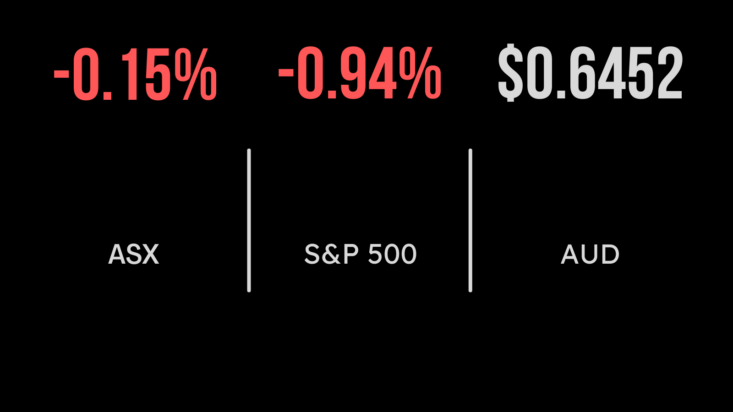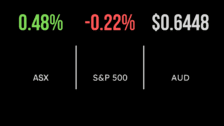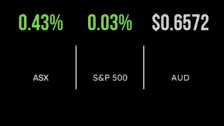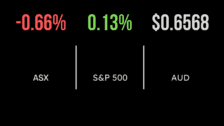Materials, Energy, and Technology fall.
The S&P/ASX 200 Index closed lower -0.6 percent on Wednesday, primarily driven by a sell-off in materials and energy stocks. The energy sector suffered the most on Wednesday, finishing lower at -1.8 percent, moderating from its recent gains. Woodside, a major oil and gas company, saw a -2.2 percent drop to $37, while Santos slid -1.9 percent to $7.70. Material stocks declined -1.1 percent, primarily driven by iron ore miners with BHP, Rio Tinto, and Fortescue Metals declining -1 percent, -1.3 percent, and -1.7 percent, respectively. In an interview with Bloomberg on Tuesday, Rio Tinto’s CEO, Jakob Stausholm, expressed concerns that China was approaching peak steel demand. Nonetheless, iron ore futures in Singapore remained close to $121.40 per tonne. Lithium stocks also faced losses on the ASX, with Core Lithium dropping -5.4 percent, Pilbara Minerals falling -2.8 percent, and Allkem slipping -1.9 percent. In corporate news, Qantas saw a late-session retreat of -2.2 percent following reports that the airline paid its former CEO, Alan Joyce, an eye-watering salary of $21.4 million in FY23, with a portion withheld pending the resolution of its ACCC case. UK Inflation surprises on the downside and a change in leadership for Sydney Airport. KMD Brands, a sports and outdoor goods retailer declined by -4.6 percent, citing cost-of-living pressures on its Kathmandu brand in its latest full-year report, despite achieving record sales of $NZ1.1 billion ($1.01 billion), up +12.6 percent from the previous year. The buy now pay later company Sezzle experienced a nearly +20 percent increase in its stock price following reports of strong earnings in August, with total income rising to $21.6 million, highlighting a +11 percent month-on-month increase and a +44 percent year-on-year increase. In other news, Scott Charlton, the outgoing CEO of Transurban, has been appointed as the new CEO of Sydney Airport, prompting a -0.4 percent decline in Transurban’s stock. Finally, Endeavour Group’s shares dipped -0.6 percent to $5.26, with non-executive director Colin Storrie stepping down from the board at the end of the year. Colin Storrie, formerly the chief financial officer of both AMP and Qantas, had joined the board six years ago. Shortly after the Australian markets closed, the United Kingdom reported unexpectedly low consumer price inflation (CPI), just one day before the anticipated rate hike by the Bank of England – muddying the waters and reducing conviction of an anticipated rate hike from 80 percent down to 50 percent. Federal Reserve’s hawkish pause and higher for longer interest rates. US shares retreated with the interest rate-sensitive Nasdaq falling -1.5 percent, the S&P 500 falling -0.9 percent, while the consumer-orientated Dow fell -0.2 percent, following the conclusion of the much-anticipated Federal Reserve’s two-day meeting. As expected, the Federal Reserve held its key policy rate at 5.25 to 5.5 percent on Wednesday. The Dot Plot on the other hand, which provides key insight on interest rate projections from the Fed Open Market Committee Members (FOMC), forecasted one more rate hike this year, and fewer rate cuts in 2024. To summarise the Fed Dot Plot expects the policy rate to be 5.6 percent in 2023, 5.1 percent in 2024, and 3.9 percent in 2025. Technology stocks retreated with Netflix Inc. falling -2.50 percent and Apple Inc. falling 2.00 percent impacted by rising bond yields as markets price in stickier inflation, and higher for longer interest rates. Whilst consumer staples, utilities, and some healthcare names outperformed, with the likes of Coca-Cola and Colgate-Palmolive both lifting marginally on Wednesday. In other news, strike negotiations between the United Auto Workers and the Detroit-Three automakers —Ford, General Motors, and Stellantis—are becoming increasingly contentious. Ford and GM stocks both declined -0.1 percent decline in early premarket trading on Tuesday, while Stellantis saw a +1.7 percent increase.











